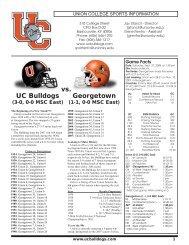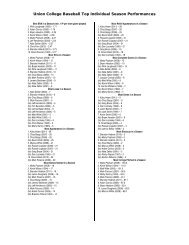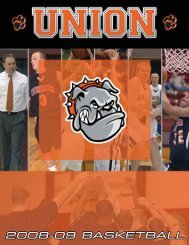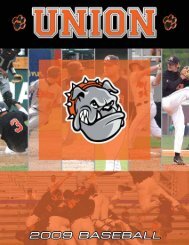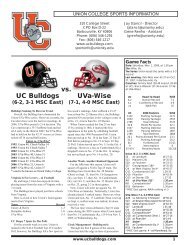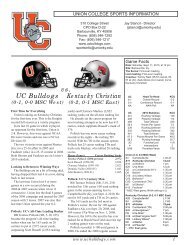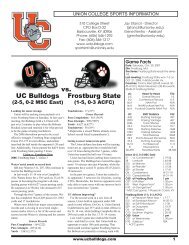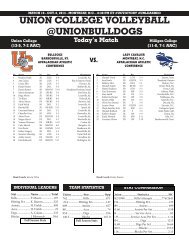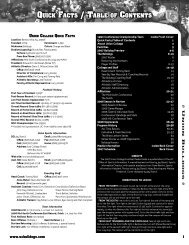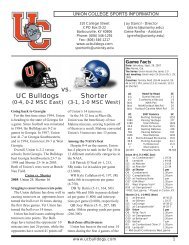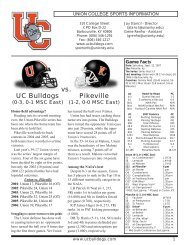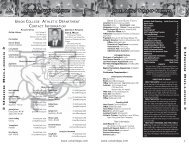quick facts / table of contents quick facts / table of contents
quick facts / table of contents quick facts / table of contents
quick facts / table of contents quick facts / table of contents
- No tags were found...
You also want an ePaper? Increase the reach of your titles
YUMPU automatically turns print PDFs into web optimized ePapers that Google loves.
The NAIA: A Proud Past, A Dynamic FutureIn searching for the NAIA’s placein the history <strong>of</strong> sports and highereducation, several consistencies arerevealed. Among them is the dedicationto academic achievement aboveathletic excellence. Also apparent isthe organization’s role as a trailblazerin providing equal opportunities forall student-athletes. Above all, thereis an expectation <strong>of</strong> ethical behaviorand a commitment to scholarship,sportsmanship and leadership.It is paradoxical that such a lasting,dynamic contribution to collegiatesports began with a mundane notein the fi rst recorded history <strong>of</strong> theAssociation: “The fi rst general session<strong>of</strong> the ‘Organizing Convention’ <strong>of</strong> theNational Association <strong>of</strong> IntercollegiateBasketball (NAIB) was held in thePhillips Hotel, Kansas City, Missouri, at10 a.m., Sunday, March 10, 1940.”But the seed from which the NAIBsprouted was planted two blocksaway at Municipal Auditorium. It was there in1937 that a men’s basketball tournament tipped<strong>of</strong>f which has become the longest continuousnational collegiate tournament in any sport.Further, out <strong>of</strong> that small-college basketballtournament, and the NAIB, grew an Associationthat now includes more than 360 colleges anduniversi ties and conducts two dozen nationalchampionship events.The tournament was the brainchild <strong>of</strong> EmilS. Liston, Dr. James Naismith, Frank Cramer, anda group <strong>of</strong> Kansas City business leaders whowanted to provide Kansas City-area fans withexciting amateur competition and to provide aframework for small colleges and universities todetermine a national basketball champion.The original eight-team tournament expandedto 32 teams in 1938 and suspended play onlyfor World War II in 1944 before 16 teamswere invited the following year and the fi eldgot back to full strength by 1946. Qualifyingtournaments became mandatory at the districtlevel in 1951.In 1948, the NAIB affi rmed its commitmentto equality by becoming the fi rst national organizationto <strong>of</strong>fer intercollegiate postseasonopportunities to black student-athletes. Unprecedentedaction was taken in 1953 whenhistorically black institutions were voted intomembership.THE NAIAOne year previous to the inclusion <strong>of</strong> historicallyblack institutions, another form <strong>of</strong> expansionoccurred. In 1952, as a result <strong>of</strong> the expresseddesires <strong>of</strong> the member institutions, appropriatesteps were taken by which the NAIB wastransformed into the National Association <strong>of</strong>Intercollegiate Athletics (NAIA), and the fi rstall-encompassing set <strong>of</strong> rules and standards wasadopted.With the Association’s new name came the addition<strong>of</strong> national championships in golf, tennis andoutdoor track and fi eld. Football, cross country,baseball and swimming and diving were addedto the championships calendar in 1956. Wrestling(1958), soccer (1959), bowling (1962-78), gymnastics(1964-84), indoor track and fi eld (1966) andmen’s volleyball (1969-80) were added later.Another significant step occurred in 1957when the Association’s headquarters movedfrom the campus <strong>of</strong> George Pepperdine Collegein Los Angeles to Kansas City to better serve themembership from a centralized location.Two major changes were made during the1970s. An extensive study was completed in1970 which paved the way for two divisions<strong>of</strong> football. In 1997, football was consolidatedto one division again as the Football CoachesAssociation cited a narrowing gap betweenenrollment size and philosophy <strong>of</strong> the two divisions.In 1976, the men’s basketball tournamentwas moved from the confi nes <strong>of</strong> the MunicipalAuditorium to Crosby Kemper Arena,also in Kansas City, marking the fi rst timesince 1937 that the tournament hadbeen held in a different arena.The NAIA revolutionized nationalcollegiate athletics with the establishment<strong>of</strong> athletics programs for womenon August 1, 1980. Offi cial notice onthat date followed a mail vote by themembership on May 1 that supportedbecoming the fi rst organization to <strong>of</strong>fercollegiate athletics to both men andwomen. Championships for womenbegan that year with basketball, crosscountry, gymnastics, indoor and outdoortrack and fi eld, s<strong>of</strong>tball, tennis andvolleyball. Soccer was added in 1984,and golf was included in 1995.Another important chapter in thehistory <strong>of</strong> the NAIA unfolded in 1992when the Association voted to moveits headquarters from Kansas City toTulsa. On August 1, 1993, the NAIAopened its doors in Tulsa and began anew era. Moving with the national <strong>of</strong>fi ce was theDivision I Men’s Basketball National Championshipwhich had been held in Kansas City for 56 years.During the 1993 NAIA National Convention inAtlanta, the waves <strong>of</strong> change once again washedover the Association. The membership votedto institute affi liated conference and regionalgroupings and discontinue the use <strong>of</strong> districtplay as a means <strong>of</strong> qualification for nationalchampionships.Since 1937, the NAIA has administered programsand championships in proper balance withthe overall educational experience. In 2000, theNAIA reaffirmed its purpose to enhance thecharacter-building aspects <strong>of</strong> sport. ThroughChampions <strong>of</strong> Character, the NAIA seeks tocreate an environment in which every studentathlete,coach, <strong>of</strong>fi cial and spectator is committedto the true spirit <strong>of</strong> competition through fi vetenets: respect, integrity, responsibility, servantleadership and sportsmanship.Everything has come full circle. The NAIArelocated its National Offi ce in July <strong>of</strong> 2001 toOlathe, Kansas, just miles from Gardner where theidea for the small-college basketball tournamentgave rise to the NAIA. Now, nearly 65 years afterthat initial tournament, the NAIA Division I Men’sBasketball National Championship returned toMunicipal Auditorium, the arena that was hometo so many memories from 1937-74.www.ucbulldogs.com21



